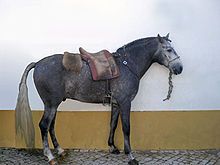 Lusitanos are generally gray, bay or chestnut, though they can be of any solid color, including black, dun and palomino. Only bays are bred at the Alter Real stud They usually stand 15.2 and 15.3 hands (62 to 63 inches, 157 to 160 cm) high, although some stand over 16 hands (64 inches, 163 cm). Members of the breed have narrow, but well-proportioned, heads with profiles that are slightly convex. The necks are thick and arched, leading to well defined withers, shoulders that are muscular and sloping and a deep, broad chest. The horses have short, strong backs and rounded, sloped croups, leading to a low-set tail. The legs are sturdy and muscled. Lusitanos are known as powerful horses, noted for their intelligence and willing nature. The breed's gaits are agile and elevated, but generally comfortable to ride. The Lusitano differs from the Andalusian through having a more sloped croup, a lower-set tail, and a more convex head profile. The mane and tail are extremely thick in both breeds.
Lusitanos are generally gray, bay or chestnut, though they can be of any solid color, including black, dun and palomino. Only bays are bred at the Alter Real stud They usually stand 15.2 and 15.3 hands (62 to 63 inches, 157 to 160 cm) high, although some stand over 16 hands (64 inches, 163 cm). Members of the breed have narrow, but well-proportioned, heads with profiles that are slightly convex. The necks are thick and arched, leading to well defined withers, shoulders that are muscular and sloping and a deep, broad chest. The horses have short, strong backs and rounded, sloped croups, leading to a low-set tail. The legs are sturdy and muscled. Lusitanos are known as powerful horses, noted for their intelligence and willing nature. The breed's gaits are agile and elevated, but generally comfortable to ride. The Lusitano differs from the Andalusian through having a more sloped croup, a lower-set tail, and a more convex head profile. The mane and tail are extremely thick in both breeds.
The ancestors of the Lusitano were originally used for classical dressage, driving and bullfighting on horseback. Today, Lusitanos are seen in Olympic disciplines, including high-level combined driving competition. In 1995, a four-in-hand team driven by Belgian Felix Brasseur won the FEI Driving World Cup, and took the World Championships in 1996. In 2002, there was a Lusitano on the World Equestrian Games bronze-winning dressage team that went on to collect a silver medal at the 2004 Summer Olympics. In 2006, the entire Portuguese dressage team rode Lusitanos at the World Equestrian Games, as did one Spanish dressage competitor. The Belgian Brasseur took the gold medal in four-in-hand driving at the same competition with a team comprised solely of Lusitanos. They are still used for mounted bullfighting today, in a form where the bull is not killed and it is a disgrace to the rider if the horse is injured. Horses bred for this sport must be agile and calm, remaining in the control of the rider even when confronted by a bull. Between 1980 and 1987, Lusitanos were used for breeding Colorado Ranger horses, although these crosses are no longer allowed by the breed registry. An Alter Real stallion, taken to Brazil prior to Napoleon's invasion, was a foundation stallion of the Mangalarga Marchador breed.
